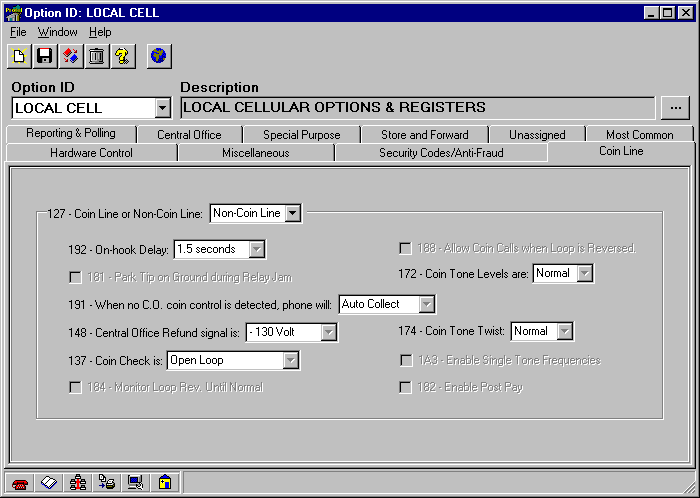Coin Line
The Coin Line tab contains options for configuring a Protel payphone to work on a coin line. The central office handles various tasks and the phone must react properly to the commands of the CO.
To get to the Coin Line tab, select
Options Records from the Configuration button in the Navigator or the Navbar to open the Options window. The Most Common tab is already selected when the Options window opens. Click on the Coin Line tab.

The Coin Line tab of the
Options window has the following options in it:
127
ñ Coin Line or Non-Coin Line: Selecting Coin Line will disable the phoneís coin functions because those functions are being provided by the local service provider. Selecting Non-Coin Line will enable the phoneís coin functions such as prompting for coin deposits and controlling the escrow relay.
The following options are dimmed (unavailable) when Non-Coin Line is chosen from option 127, directly above, because they are only used on coin lines:
192
ñ On-hook Delay: Choose 1.5 or 4.0 seconds as the amount of time that the phone should remain on hook in the event that the user flashes the hookswitch or the phone drops and picks up the line again. This is to give the service provider enough time to send a signal to the phone to either collect or return the coins. If the time is too short, the service provider may not return the dialtone and the digits that the phone dials will not be received by the provider.
181
ñ Park Tip on Ground During Relay Jam: Check the box if the tip should automatically be connected to the ground if a relay jam occurs. This notifies the central office that a problem has occurred.
191
ñ When no Central Office coin control is detected, phone will: Choose whether the phone will refund or collect the deposited money if no signal is detected from the central office.
148
ñ Central Office Refund signal is: Usually, the central office will send a +130 Volt pulse to collect the coins and a ñ130 Volt pulse to return the coins. Select whether the central office operates in this manner or the opposite.
137
ñ Coin Check is: Contact the Central Office to determine whether Continuous Ground or Open Loop should be chosen in order to work with the equipment present in the central office.
184
ñ Monitor Loop Reversal Until Normal: Check the box to have the phone automatically come off hook and stay off hook until the loop returns to normal. If this is unchecked, the phone will go back on hook while the loop is reversed, and the reversed polarity will look like a refund signal. This option is not used when 182 ñ Enable Post Pay is checked (see below).
188
ñ Allow Coin Calls when Loop is Reversed: Check the box to continue allowing coin calls if the loop is reversed. If the particular phone simply looks for a reversal of loop polarity (whether it started off reversed or not), and the phoneís collect/refund operation is not effected by the condition, this option can be checked. If the phone relies on the polarity being correct during normal operation and reversed for a refund, checking this option will result in refunds of coin calls if the line is reversed in normal operation.
172
ñ Coin Tone Levels are: Select High or Normal to send coin tones at high or normal amplitude (loudness). Specifically: High = -10dBm, Low = -14dBm.
174
ñ Coin Tone Twist: A coin tone actually consists of two tones at two different frequencies that are played at the same time. Twist is the term used to indicate that one frequency is louder than the other. Normal twist is when the higher of the two frequencies is louder. Reversed twist is when the lower of the two frequencies is louder. Specifically, the two frequencies are: 2.2 KHz and 1.7 KHz.
1A3
ñ Enable Single Tone Frequencies: In Canada, the coin tones are not two frequencies, but only the 1.7 KHz frequency. In order to work with equipment made to detect the single-frequency tone, this checkbox must be checked.
182
ñ Enable Post Pay: In the post-pay method, the payphone user first dials a phone number. The call is connected, but the microphone is disabled. The payphone user can hear when the other party answers the call, but the microphone stays disabled until the user deposits the required amount. Once the amount is reached, the microphone is opened. In this type of call, money is not refunded. The money deposited falls directly into the coin box.